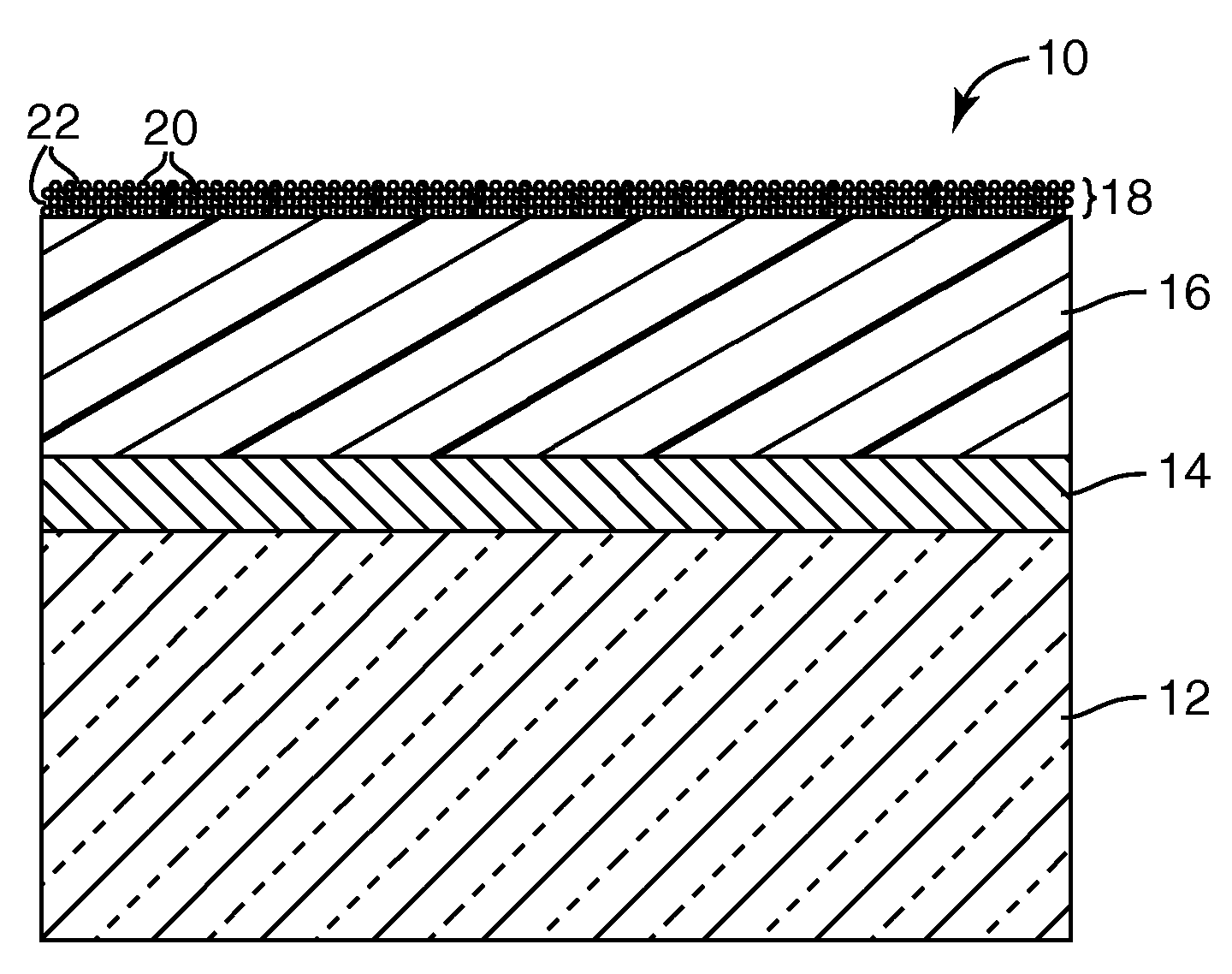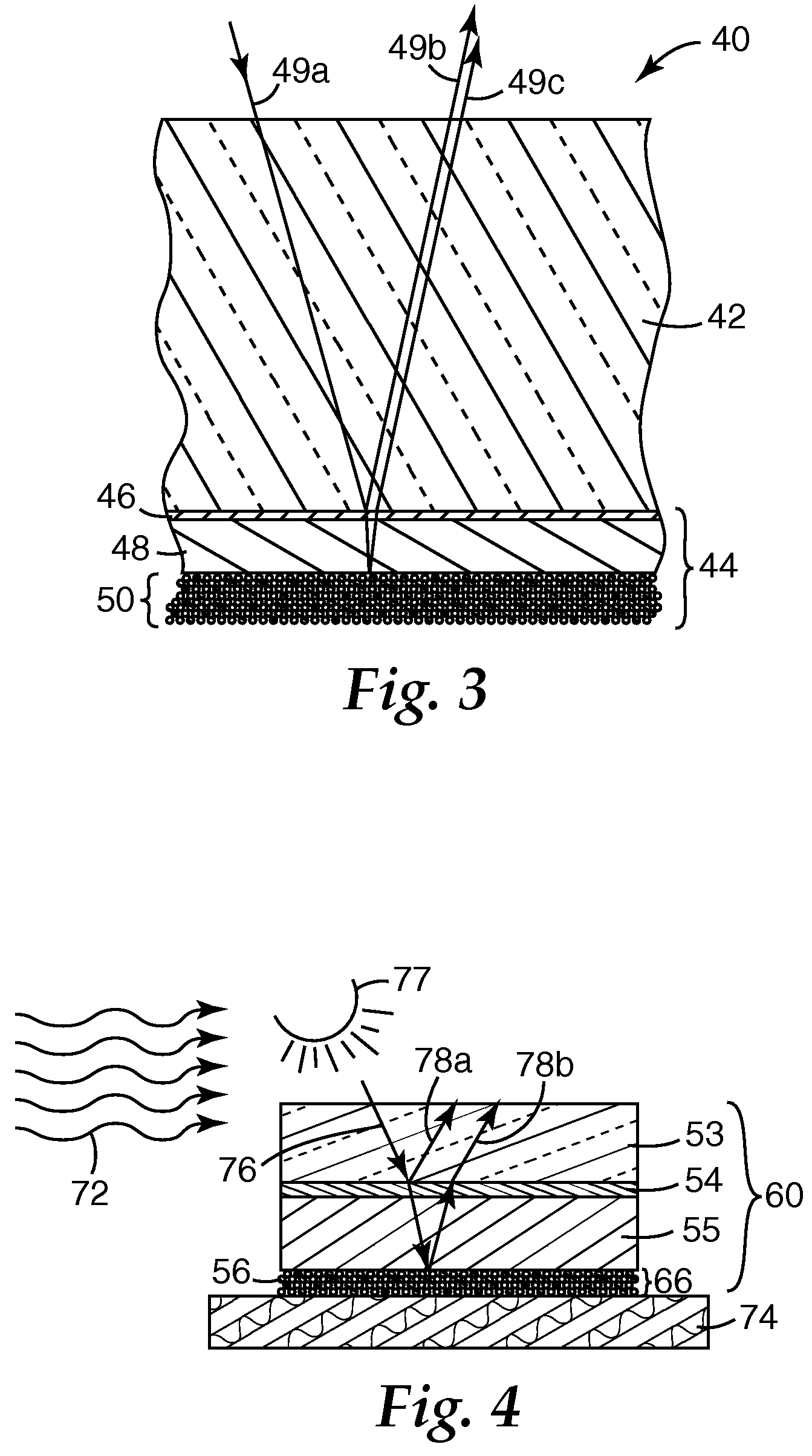Permeable nanoparticle reflector
a nanoparticle reflector and nanoparticle technology, applied in the direction of chemical indicator analysis, optical radiation measurement, instruments, etc., can solve the problems of affecting the optical response of the detection layer, requiring specialized equipment, and requiring several exact steps, so as to achieve the effect of simple operation and lower reflectivity
- Summary
- Abstract
- Description
- Claims
- Application Information
AI Technical Summary
Benefits of technology
Problems solved by technology
Method used
Image
Examples
example 1
[0056]A thin film indicator was prepared using polymers of intrinsic microporosity (PIMs) as the detection layer, an Au / Pd semireflective layer, and a silver nanoparticle vapor-permeable reflective layer. PIM polymer was prepared from the monomers BC and FA generally according to the procedure reported by Budd et al. in Advanced Materials, 2004, Vol. 16, No. 5, pp. 456-459. 9.0 grams of BC were combined with 5.28 g of FA, 18.0 g potassium carbonate, and 120 milliliters of DMF and the mixture was reacted at 70° C. for 24 hours. The resulting polymer was dissolved in THF, precipitated three times from methanol, and then dried under vacuum at room temperature. A yellow solid product was obtained having a molecular weight (Mw) of 61,800.
[0057]A glass slide was sputter coated with a 5 nm thick layer of Au / Pd, using a DENTON™ Vacuum Desk II sputter coater from Denton Vacuum equipped with an Au / Pd target with a 60:40 Au:Pd mass ratio. The sputter coating power and coating duration were 35 ...
example 2
[0059]Using the method of Example 1, 1 mm thick glass slides were sputter coated with a 5 nm thick layer of Au / Pd, followed by spin-coating (at 1500 rpm) a layer of PIM polymer onto the Au / Pd layer. Using the method of Example 1 (Indicator B), a diluted SVE 102 silver nanoparticle suspension was spin-coated onto the PIM film to provide a vapor-permeable nanoparticle reflective layer. The resulting thin-film indicator had a green-yellow appearance when visually observed through the glass slide. DYMAX™ No. OP-4-20641A UV-cure optical adhesive from Dymax Corporation was used to adhere the indicator to the inside sidewall of a filtration cartridge made from clear polycarbonate resin, with the vapor-permeable nanoparticle reflective layer facing the cartridge interior. The cartridge was filled with 45.7 g of activated carbon sorbent. Several small holes were drilled in the cartridge cover immediately above and upstream from the indicator to ensure adequate vapor flow at the indicator / sor...
example 3
[0061]Using the method of Example 1, PIM polymer was prepared from the monomers BC and FA. Using a CHA Industries Mark-50 evaporator operated at a base pressure of 1×10−5 torr and No. T-2003 titanium pellets (99.995% purity, 6×6 mm, from Cerac Inc.), cleaned glass slides were metallized with a 10 nm thick semireflective Ti layer. A 4% solution of the PIM polymer in chlorobenzene was spin-coated onto the Ti layer at 1000 rpm. Using the method of Example 1 (Indicator B), a diluted SVE 102 silver nanoparticle suspension was spin-coated onto the PIM film to provide a vapor-permeable reflective layer. Following silver nanoparticle deposition, the film sample was heated at 150° C. in air for 1 hour. The resulting thin-film indicator had a green appearance when visually observed through the glass slide. DYMAX™ No. OP-4-20641A UV-cure optical adhesive was used to adhere the indicator to an additional glass slide layer. The resulting glass slide stack was adhered to the inner sidewall of a f...
PUM
| Property | Measurement | Unit |
|---|---|---|
| particle diameter | aaaaa | aaaaa |
| thickness | aaaaa | aaaaa |
| thickness | aaaaa | aaaaa |
Abstract
Description
Claims
Application Information
 Login to View More
Login to View More - R&D
- Intellectual Property
- Life Sciences
- Materials
- Tech Scout
- Unparalleled Data Quality
- Higher Quality Content
- 60% Fewer Hallucinations
Browse by: Latest US Patents, China's latest patents, Technical Efficacy Thesaurus, Application Domain, Technology Topic, Popular Technical Reports.
© 2025 PatSnap. All rights reserved.Legal|Privacy policy|Modern Slavery Act Transparency Statement|Sitemap|About US| Contact US: help@patsnap.com



